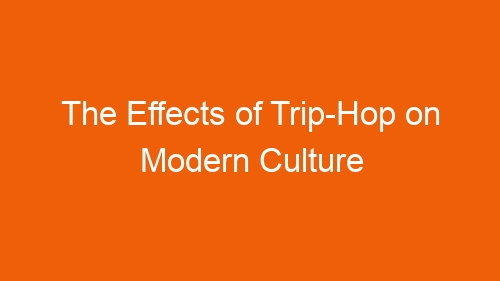-
Table of Contents
Influence of Trip-Hop on Fashion Trends
Trip-hop, a genre of music that emerged in the 1990s, has had a significant impact on modern culture in various ways. One of the areas where its influence is most evident is in the world of fashion. The unique sound and aesthetic of trip-hop have inspired designers, influencers, and consumers alike, shaping trends and styles that continue to resonate today.
One of the key characteristics of trip-hop is its fusion of different genres, including hip-hop, electronic, and ambient music. This eclectic mix of influences is reflected in the fashion associated with the genre, which often combines elements of streetwear, high fashion, and vintage clothing. The result is a style that is both edgy and sophisticated, with a focus on individuality and self-expression.
Trip-hop’s emphasis on mood and atmosphere has also had a significant impact on fashion trends. The genre’s dark, brooding sound has inspired designers to create collections that are moody and introspective, with a focus on texture, silhouette, and color. This has led to the popularity of oversized, layered looks, as well as a resurgence of 90s-inspired fashion, such as baggy jeans, crop tops, and platform shoes.
In addition to influencing the aesthetics of fashion, trip-hop has also played a role in shaping the way that clothing is marketed and consumed. The genre’s emphasis on authenticity and creativity has resonated with consumers who are looking for brands that align with their values and beliefs. As a result, many fashion labels have embraced the DIY ethos of trip-hop, creating collections that are handmade, sustainable, and ethically produced.
Furthermore, trip-hop’s emphasis on collaboration and community has inspired designers to work with artists, musicians, and other creatives to create unique and innovative collections. This has led to a blurring of the lines between fashion and other art forms, with designers incorporating elements of music, film, and visual art into their work.
Overall, the influence of trip-hop on fashion trends can be seen in the way that designers, influencers, and consumers approach style and self-expression. The genre’s eclectic mix of influences, moody atmosphere, and emphasis on authenticity and creativity have shaped the way that clothing is designed, marketed, and consumed. As a result, trip-hop continues to be a source of inspiration for those who are looking to push boundaries and challenge conventions in the world of fashion.
Evolution of Trip-Hop in Mainstream Music
Trip-hop is a genre of music that emerged in the 1990s, blending elements of hip-hop, electronic music, and various other genres such as jazz, funk, and soul. It is characterized by its slow tempo, atmospheric soundscapes, and often melancholic or introspective lyrics. While trip-hop initially gained popularity in underground music scenes, it eventually made its way into mainstream culture, influencing a wide range of artists and genres along the way.
One of the key factors in the evolution of trip-hop in mainstream music was the success of artists such as Massive Attack, Portishead, and Tricky in the 1990s. These artists helped to popularize the genre with their unique sound and innovative production techniques. Massive Attack’s debut album, “Blue Lines,” released in 1991, is often credited as one of the first trip-hop albums and helped to establish the genre’s signature sound.
As trip-hop gained popularity in the mainstream, it began to influence a wide range of artists across different genres. Many hip-hop artists began incorporating trip-hop elements into their music, blending the two genres to create a new and unique sound. Artists such as Kanye West, Gorillaz, and Kendrick Lamar have all been influenced by trip-hop in their music, incorporating its atmospheric soundscapes and production techniques into their own work.
In addition to influencing hip-hop artists, trip-hop has also had a significant impact on electronic music. Artists such as Bonobo, Thievery Corporation, and Zero 7 have all drawn inspiration from trip-hop in their music, creating a new wave of electronic music that blends elements of trip-hop with other genres such as downtempo, ambient, and chillout.
The influence of trip-hop can also be seen in other areas of popular culture, such as film and television. Many filmmakers and television producers have used trip-hop music in their soundtracks to create a certain mood or atmosphere in their work. The use of trip-hop in films such as “The Matrix” and television shows like “CSI” has helped to further popularize the genre and introduce it to new audiences.
Overall, the evolution of trip-hop in mainstream music has had a lasting impact on modern culture. Its unique sound and production techniques have influenced a wide range of artists across different genres, helping to shape the musical landscape of today. As trip-hop continues to evolve and grow, its influence on popular culture is likely to only increase, solidifying its place as a key genre in the world of music.
Impact of Trip-Hop on Visual Arts and Film Industry
Trip-hop, a genre of music that emerged in the 1990s, has had a profound impact on modern culture, influencing not only the music industry but also visual arts and the film industry. This unique genre, characterized by its blend of hip-hop beats, electronic sounds, and atmospheric textures, has inspired artists and filmmakers to create innovative and thought-provoking works that push the boundaries of creativity and expression.
In the realm of visual arts, trip-hop has served as a source of inspiration for many artists seeking to explore new ways of representing the world around them. The genre’s moody and introspective soundscapes have been translated into visual form through the use of dark and atmospheric imagery, creating a sense of mystery and intrigue that captivates viewers. Artists such as Banksy, known for his politically charged street art, have drawn on the themes of alienation and urban decay often found in trip-hop music to create powerful and evocative works that challenge societal norms and provoke thought.
Furthermore, trip-hop’s emphasis on mood and atmosphere has influenced the way in which filmmakers approach storytelling and visual aesthetics. Directors such as David Fincher and Darren Aronofsky have incorporated trip-hop elements into their films, using its hypnotic rhythms and haunting melodies to enhance the emotional impact of their narratives. Films like “Fight Club” and “Requiem for a Dream” feature soundtracks heavily influenced by trip-hop, creating a sense of unease and tension that mirrors the psychological turmoil experienced by the characters on screen.
The use of trip-hop in film has also extended to the realm of film scoring, with composers like Trent Reznor and Atticus Ross incorporating trip-hop elements into their soundtracks to create a sense of unease and tension that mirrors the psychological turmoil experienced by the characters on screen. This blending of music and visuals has resulted in a new form of storytelling that challenges traditional narrative structures and invites viewers to engage with the film on a deeper emotional level.
Overall, the impact of trip-hop on visual arts and the film industry cannot be overstated. Its moody and atmospheric soundscapes have inspired artists and filmmakers to push the boundaries of creativity and expression, creating works that challenge societal norms and provoke thought. By incorporating trip-hop elements into their art and film, creators have been able to create a new form of storytelling that engages viewers on a deeper emotional level, leaving a lasting impact on modern culture.




















